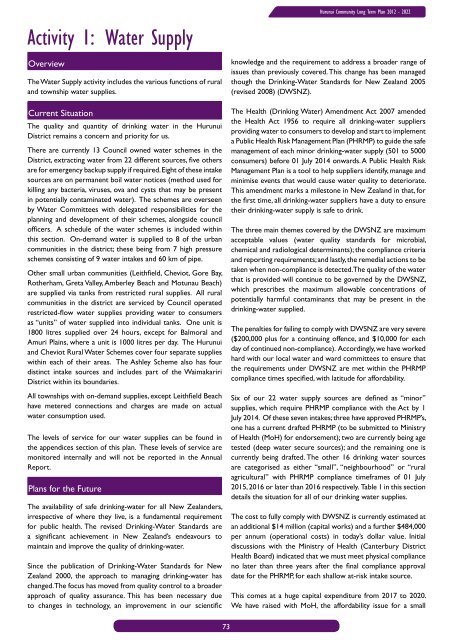Draft Long Term Plan 2012-2022 - Hurunui District Council
Draft Long Term Plan 2012-2022 - Hurunui District Council
Draft Long Term Plan 2012-2022 - Hurunui District Council
You also want an ePaper? Increase the reach of your titles
YUMPU automatically turns print PDFs into web optimized ePapers that Google loves.
Activity 1: Water SupplyOverviewThe Water Supply activity includes the various functions of ruraland township water supplies.Current SituationThe quality and quantity of drinking water in the <strong>Hurunui</strong><strong>District</strong> remains a concern and priority for us.There are currently 13 <strong>Council</strong> owned water schemes in the<strong>District</strong>, extracting water from 22 different sources, five othersare for emergency backup supply if required. Eight of these intakesources are on permanent boil water notices (method used forkilling any bacteria, viruses, ova and cysts that may be presentin potentially contaminated water). The schemes are overseenby Water Committees with delegated responsibilities for theplanning and development of their schemes, alongside councilofficers. A schedule of the water schemes is included withinthis section. On-demand water is supplied to 8 of the urbancommunities in the district; these being from 7 high pressureschemes consisting of 9 water intakes and 60 km of pipe.Other small urban communities (Leithfield, Cheviot, Gore Bay,Rotherham, Greta Valley, Amberley Beach and Motunau Beach)are supplied via tanks from restricted rural supplies. All ruralcommunities in the district are serviced by <strong>Council</strong> operatedrestricted-flow water supplies providing water to consumersas “units” of water supplied into individual tanks. One unit is1800 litres supplied over 24 hours, except for Balmoral andAmuri Plains, where a unit is 1000 litres per day. The <strong>Hurunui</strong>and Cheviot Rural Water Schemes cover four separate supplieswithin each of their areas. The Ashley Scheme also has fourdistinct intake sources and includes part of the Waimakariri<strong>District</strong> within its boundaries.All townships with on-demand supplies, except Leithfield Beachhave metered connections and charges are made on actualwater consumption used.The levels of service for our water supplies can be found inthe appendices section of this plan. These levels of service aremonitored internally and will not be reported in the AnnualReport.<strong>Plan</strong>s for the FutureThe availability of safe drinking-water for all New Zealanders,irrespective of where they live, is a fundamental requirementfor public health. The revised Drinking-Water Standards area significant achievement in New Zealand’s endeavours tomaintain and improve the quality of drinking-water.Since the publication of Drinking-Water Standards for NewZealand 2000, the approach to managing drinking-water haschanged. The focus has moved from quality control to a broaderapproach of quality assurance. This has been necessary dueto changes in technology, an improvement in our scientific<strong>Hurunui</strong> Community <strong>Long</strong> <strong>Term</strong> <strong>Plan</strong> <strong>2012</strong> - <strong>2022</strong>knowledge and the requirement to address a broader range ofissues than previously covered. This change has been managedthough the Drinking-Water Standards for New Zealand 2005(revised 2008) (DWSNZ).The Health (Drinking Water) Amendment Act 2007 amendedthe Health Act 1956 to require all drinking-water suppliersproviding water to consumers to develop and start to implementa Public Health Risk Management <strong>Plan</strong> (PHRMP) to guide the safemanagement of each minor drinking-water supply (501 to 5000consumers) before 01 July 2014 onwards. A Public Health RiskManagement <strong>Plan</strong> is a tool to help suppliers identify, manage andminimise events that would cause water quality to deteriorate.This amendment marks a milestone in New Zealand in that, forthe first time, all drinking-water suppliers have a duty to ensuretheir drinking-water supply is safe to drink.The three main themes covered by the DWSNZ are maximumacceptable values (water quality standards for microbial,chemical and radiological determinants); the compliance criteriaand reporting requirements; and lastly, the remedial actions to betaken when non-compliance is detected. The quality of the waterthat is provided will continue to be governed by the DWSNZ,which prescribes the maximum allowable concentrations ofpotentially harmful contaminants that may be present in thedrinking-water supplied.The penalties for failing to comply with DWSNZ are very severe($200,000 plus for a continuing offence, and $10,000 for eachday of continued non-compliance). Accordingly, we have workedhard with our local water and ward committees to ensure thatthe requirements under DWSNZ are met within the PHRMPcompliance times specified, with latitude for affordability.Six of our 22 water supply sources are defined as “minor”supplies, which require PHRMP compliance with the Act by 1July 2014. Of these seven intakes; three have approved PHRMP’s,one has a current drafted PHRMP (to be submitted to Ministryof Health (MoH) for endorsement); two are currently being agetested (deep water secure sources); and the remaining one iscurrently being drafted. The other 16 drinking water sourcesare categorised as either “small”, “neighbourhood” or “ruralagricultural” with PHRMP compliance timeframes of 01 July2015, 2016 or later than 2016 respectively. Table 1 in this sectiondetails the situation for all of our drinking water supplies.The cost to fully comply with DWSNZ is currently estimated atan additional $14 million (capital works) and a further $484,000per annum (operational costs) in today’s dollar value. Initialdiscussions with the Ministry of Health (Canterbury <strong>District</strong>Health Board) indicated that we must meet physical complianceno later than three years after the final compliance approvaldate for the PHRMP, for each shallow at-risk intake source.This comes at a huge capital expenditure from 2017 to 2020.We have raised with MoH, the affordability issue for a small73
















